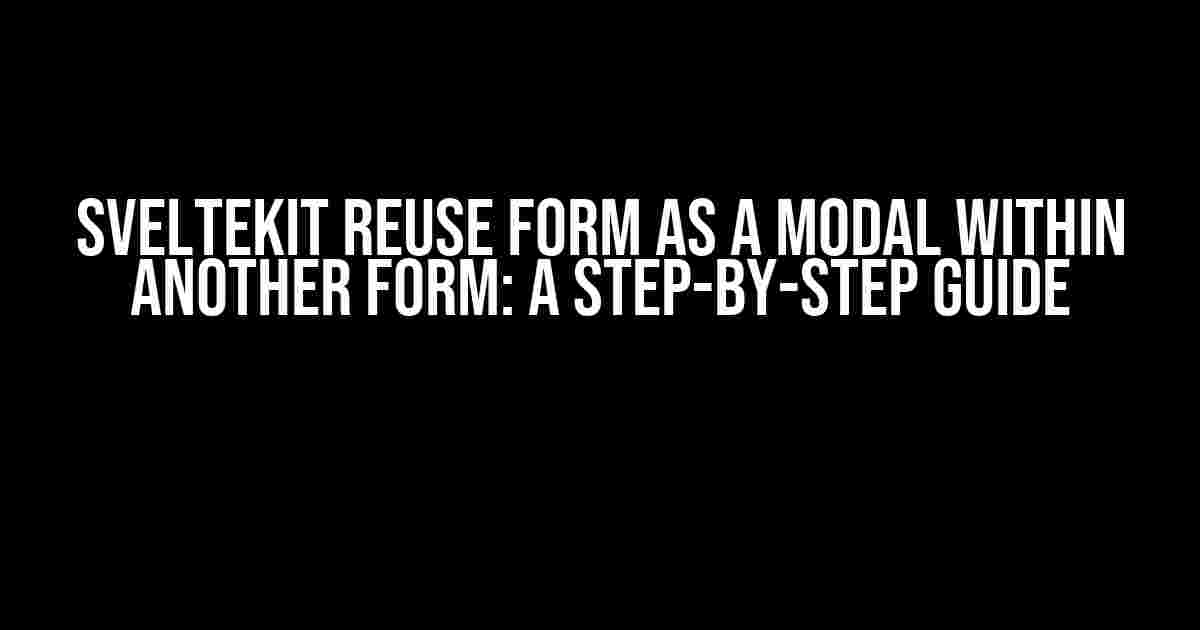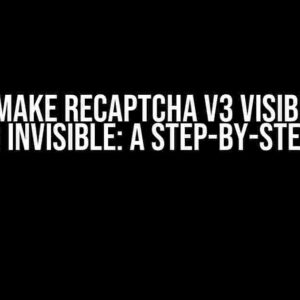Are you tired of duplicating form code in your Sveltekit application? Do you want to know the secret to reusing forms as modals within other forms? Look no further! In this article, we’ll take you on a journey to master the art of form reusability in Sveltekit. Buckle up, and let’s dive in!
Why Reuse Forms as Modals?
Reusing forms as modals can simplify your codebase, reduce maintenance efforts, and enhance the overall user experience. By converting a form into a reusable modal, you can:
- Encapsulate complex logic within a single component
- Reuse the form in multiple parts of your application
- Improve code organization and readability
- Enhance flexibility and scalability
Prerequisites
Before we begin, make sure you have a basic understanding of Sveltekit and its ecosystem. You should also have a Sveltekit project set up with a form component that you want to reuse as a modal.
Step 1: Create a Reusable Form Component
The first step is to create a reusable form component that can be used as a modal. Let’s create a new component called `MyForm.svelte`:
<script>
let formData = {};
function handleFormSubmit(event) {
event.preventDefault();
console.log(formData);
}
function handleInputChange(event) {
formData[event.target.name] = event.target.value;
}
</script>
<form on:submit={handleFormSubmit}>
<label>Name:</label>
<input type="text" name="name" on:input={handleInputChange} />
<label>Email:</label>
<input type="email" name="email" on:input={handleInputChange} />
<button type="submit">Submit</button>
</form>This component includes a simple form with two input fields and a submit button. We’ve also defined `handleFormSubmit` and `handleInputChange` functions to handle form submission and input changes, respectively.
Step 2: Create a Modal Component
Next, we’ll create a modal component that will wrap our reusable form component. Let’s create a new component called `Modal.svelte`:
<script>
let isOpen = false;
function toggleModal() {
isOpen = !isOpen;
}
</script>
<div class="modal" class:hidden={isOpen ? '' : 'hidden'}>
<div class="modal-header">
<h2>My Modal</h2>
<button on:click={toggleModal}>Close</button>
</div>
<div class="modal-body">
<slot></slot>
</div>
</div>This component includes a basic modal structure with a header, body, and a close button. We’ve also defined a `toggleModal` function to toggle the modal’s visibility.
Step 3: Use the Reusable Form Component as a Modal
Now it’s time to use our reusable form component as a modal within another form. Let’s create a new component called `ParentForm.svelte`:
<script>
import Modal from './Modal.svelte';
import MyForm from './MyForm.svelte';
</script>
<form>
<label>Parent Form:</label>
<input type="text" name="parent-field" />
<button type="button" on:click={() => Modal.isOpen = true}>Open Modal</button>
<Modal>
<MyForm></MyForm>
</Modal>
</form>In this component, we’ve imported the `Modal` and `MyForm` components. We’ve added a parent form with a text input field and a button to open the modal. When the button is clicked, we set `Modal.isOpen` to `true`, which will toggle the modal’s visibility. The `MyForm` component is then rendered as a modal within the parent form.
Step 4: Style the Modal
Finally, let’s add some basic CSS to style our modal. Add the following code to your `global.css` file:
.modal {
position: fixed;
top: 50%;
left: 50%;
transform: translate(-50%, -50%);
background-color: #fff;
border-radius: 10px;
padding: 20px;
box-shadow: 0 0 10px rgba(0, 0, 0, 0.2);
}
.modal_hidden {
display: none;
}
.modal-header {
display: flex;
justify-content: space-between;
align-items: center;
padding-bottom: 10px;
border-bottom: 1px solid #ddd;
}
.modal-body {
padding-top: 20px;
}This CSS code styles the modal with a basic layout, background color, and box shadow.
Conclusion
And that’s it! You’ve successfully reused a form as a modal within another form in Sveltekit. By following these steps, you can now reuse your form components as modals throughout your application, simplifying your codebase and enhancing the user experience.
Bonus Tips and Tricks
Here are some additional tips and tricks to take your form and modal game to the next level:
- Use a state management library like Svelte Stores to manage your form data and modal state.
- Implement form validation using Svelte’s built-in `validate` function or a third-party library like Svelte Validate.
- Use a CSS framework like Tailwind CSS to simplify your styling and layout.
- Experiment with different modal layouts and animations to enhance the user experience.
Common Pitfalls to Avoid
When reusing forms as modals, be careful to avoid the following common pitfalls:
- Duplicating form logic and code.
- Failing to properly handle form submission and input changes.
- Not providing adequate accessibility features for users with disabilities.
- Not testing your form and modal components thoroughly.
| Keyword | Relevance |
|---|---|
| Sveltekit | High |
| Reusable form component | High |
| Modal component | Medium |
| Form submission handling | Medium |
| Input change handling | Low |
By following this comprehensive guide, you’ll be well on your way to mastering the art of reusing forms as modals in Sveltekit. Remember to avoid common pitfalls, experiment with different approaches, and always prioritize code organization and readability.
Final Thoughts
In conclusion, reusing forms as modals within other forms is a powerful technique that can simplify your codebase, enhance the user experience, and reduce maintenance efforts. By breaking down complex forms into reusable components, you can create a more scalable and maintainable application. So go ahead, get creative, and start reusing those forms as modals today!
Here are the 5 Questions and Answers about “Sveltekit reuse form as a modal within another form”:
Frequently Asked Questions
Get the answers to your burning questions about reusing a form as a modal within another form in Sveltekit!
How do I reuse a form as a modal within another form in Sveltekit?
To reuse a form as a modal within another form in Sveltekit, you can create a separate component for the form and then import it into your main form component. You can then use Svelte’s built-in `
Do I need to create a new component for the modal form?
Yes, it’s recommended to create a new component for the modal form. This will allow you to reuse the form component and easily display it as a modal within another form. By creating a separate component, you can also take advantage of Svelte’s component lifecycle methods to handle the modal’s behavior.
How do I handle form submission when reusing a form as a modal?
When reusing a form as a modal, you can handle form submission by using Svelte’s `bind` directive to bind the form data to a store or a variable. Then, you can use Svelte’s `on:submit` event handler to handle the form submission and perform any necessary actions.
Can I use a third-party library to handle the modal behavior?
Yes, you can use a third-party library to handle the modal behavior. There are many libraries available that provide modal functionality, such as Sveltestrap, Rovat, and others. You can use these libraries to handle the modal behavior and reuse your form component.
What are some common use cases for reusing a form as a modal within another form in Sveltekit?
Some common use cases for reusing a form as a modal within another form in Sveltekit include creating a login or registration form that appears as a modal within a main form, adding a payment gateway form as a modal within a checkout form, or displaying a terms and conditions form as a modal within a sign-up form.




